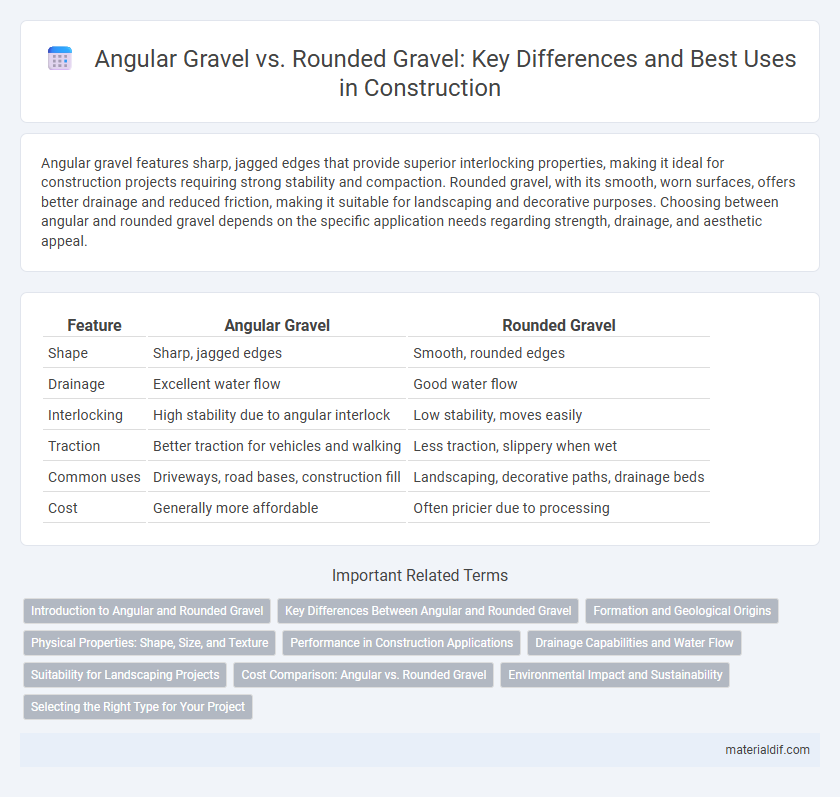Angular gravel features sharp, jagged edges that provide superior interlocking properties, making it ideal for construction projects requiring strong stability and compaction. Rounded gravel, with its smooth, worn surfaces, offers better drainage and reduced friction, making it suitable for landscaping and decorative purposes. Choosing between angular and rounded gravel depends on the specific application needs regarding strength, drainage, and aesthetic appeal.
Table of Comparison
| Feature | Angular Gravel | Rounded Gravel |
|---|---|---|
| Shape | Sharp, jagged edges | Smooth, rounded edges |
| Drainage | Excellent water flow | Good water flow |
| Interlocking | High stability due to angular interlock | Low stability, moves easily |
| Traction | Better traction for vehicles and walking | Less traction, slippery when wet |
| Common uses | Driveways, road bases, construction fill | Landscaping, decorative paths, drainage beds |
| Cost | Generally more affordable | Often pricier due to processing |
Introduction to Angular and Rounded Gravel
Angular gravel features sharp, jagged edges created by mechanical crushing, offering excellent compaction and interlock properties for construction and drainage applications. Rounded gravel, formed by natural weathering and water erosion, has smooth, curved surfaces that facilitate better water flow and reduce friction in landscaping and decorative uses. Choosing between angular and rounded gravel depends on the specific project requirements for stability, drainage, and aesthetic appeal.
Key Differences Between Angular and Rounded Gravel
Angular gravel features sharp, jagged edges, providing superior interlocking and stability ideal for construction and drainage projects. Rounded gravel exhibits smooth, worn surfaces due to natural weathering, making it more suitable for landscaping and decorative uses. The key differences lie in texture, compaction properties, and application, where angular gravel enhances structural integrity while rounded gravel offers aesthetic appeal and ease of movement.
Formation and Geological Origins
Angular gravel forms through mechanical weathering and fracturing, resulting in sharp edges and irregular shapes. It is typically derived from the rapid breakdown of rocks such as granite or basalt in high-energy environments like mountain streams or glacial deposits. Rounded gravel develops from prolonged abrasion and transport in riverbeds or coastal areas, where continuous water action smooths and rounds the particles over time.
Physical Properties: Shape, Size, and Texture
Angular gravel features sharp edges and rough surfaces, providing excellent interlocking properties that enhance stability in construction projects. Rounded gravel exhibits smooth, curved shapes with smaller surface area contact, resulting in better drainage but less compaction strength. Size variation in angular gravel ranges from coarse to fine, while rounded gravel typically presents a more uniform size distribution, influencing its suitability for different applications.
Performance in Construction Applications
Angular gravel provides superior compaction and interlocking properties, enhancing load-bearing capacity and stability in construction applications. Rounded gravel offers better drainage and is easier to work with but lacks the mechanical strength required for high-performance foundations. Selecting angular gravel improves structural integrity and reduces settlement issues in projects like road bases and concrete mixes.
Drainage Capabilities and Water Flow
Angular gravel features sharp edges and irregular shapes that create larger void spaces, promoting superior drainage capabilities and faster water flow compared to rounded gravel. Rounded gravel, with its smooth, compact shape, tends to pack more tightly, reducing permeability and slowing water movement. This makes angular gravel ideal for applications requiring efficient water drainage and reduced surface runoff.
Suitability for Landscaping Projects
Angular gravel offers superior interlocking properties and stability, making it ideal for structural landscaping projects such as pathways, driveways, and retaining walls. Rounded gravel, with its smooth texture and aesthetic appeal, is better suited for decorative purposes like garden beds and water features where drainage and softness are prioritized. Selecting the appropriate gravel type depends on the required stability and visual effect in landscape design.
Cost Comparison: Angular vs. Rounded Gravel
Angular gravel typically costs less than rounded gravel due to simpler production processes and abundant local availability. Rounded gravel demands higher transportation and processing expenses, increasing its market price. Choosing angular gravel often provides a more budget-friendly option without compromising structural integrity in construction projects.
Environmental Impact and Sustainability
Angular gravel, often composed of crushed stone, offers improved interlocking and stability but requires intensive quarrying processes that lead to higher environmental degradation and energy consumption. Rounded gravel, naturally smoothed by water erosion, typically involves less extraction impact and promotes better water drainage, enhancing soil permeability and reducing runoff pollution. Choosing rounded gravel supports more sustainable landscaping and infrastructure projects by minimizing habitat disruption and encouraging natural water filtration.
Selecting the Right Type for Your Project
Choosing between angular and rounded gravel depends on the specific requirements of your project; angular gravel offers superior compaction and stability due to its jagged edges, making it ideal for construction bases and driveways. Rounded gravel, with its smoother texture, provides better drainage and a more polished appearance, preferred for landscaping and decorative purposes. Evaluating factors such as load-bearing needs, drainage, and aesthetic goals ensures the selection aligns with the project's functional and visual demands.
Angular gravel vs Rounded gravel Infographic

 materialdif.com
materialdif.com